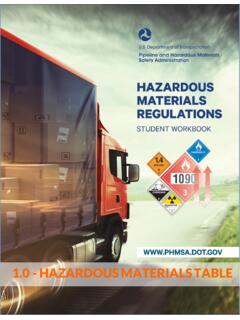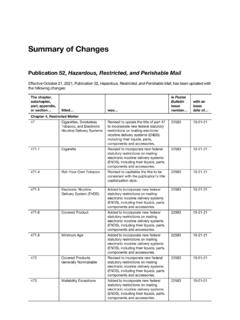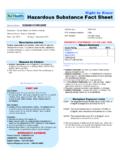Transcription of Hazardous Materials List - Fairtrade International
1 1 Fairtrade Hazardous Materials List Hazardous Materials List Version: v All agrochemicals, especially pesticides, can be potentially Hazardous in some form or other to human and animal health as well as to the environment and therefore should be used only under caution. Fairtrade International recommends the use of other methods like proper choice of crops and varieties, suitable cultivation practices and biological material for pest, before a chemical pesticide is used for pest control. The Hazardous Materials List (HML) is divided in three lists: the Red List, the Orange List and the Yellow List. Red List: The Red List is a prohibited list and includes Materials that must not be used on Fairtrade products.
2 Orange List: The Orange List is a restricted List and includes Materials that may be used under conditions specified in this document thus restricting their use. The use of Materials in this list will be monitored by Fairtrade International . Operators should be aware that some of these Materials are to be phased out by 30 June 2020 or by 30 June 2022 as indicated in the list. The other Materials in the list may eventually be prohibited and are encouraged to abandon their use. Yellow List: The Yellow List is a flagged list and includes Materials which are flagged for being Hazardous and should be used under extreme caution. Fairtrade International will be monitoring the classification of these Materials by International bodies like PAN, WHO and FAO, and Materials may be prohibited in the future.
3 Operators are encouraged to abandon their use. Classification of Materials in the HML The Hazardous Materials List includes Materials that are identified as Highly Hazardous as defined in the Code of Conduct on Pesticide Management adopted by FAO and WHO in 2013. The HML has been build based on information from PAN International List of Highly Hazardous Pesticides (HHP). Highly Hazardous Pesticides (FAO/WHO) Highly Hazardous Pesticides means pesticides that are acknowledged to present particularly high levels of acute or chronic hazards to health or environment according to internationally accepted classification systems such as WHO or GHS or their listing in relevant binding International agreements or conventions.
4 In addition, pesticides that appear to cause severe or irreversible harm to health or the environment under conditions of use in a country may be considered to be and treated as highly Hazardous . Hazard means the inherent property of a substance, agent or situation having the potential to cause undesirable consequences ( properties that can cause adverse effects or damage to health, the environment or property). 2 Fairtrade Hazardous Materials List Hazard criteria for identification of Highly Hazardous Pesticides1 Hazard criteria Measure (hazard classifications used) Conventions Persistent Organic Pollutants (Stockholm Convention) PIC substances (The Rotterdam Convention on the Prior Information Consent Procedure for Certain Hazardous Chemicals and Pesticides in International Trade) Ozone depleting substances (Montreal Protocol) High acute toxicity Extremely Hazardous (Class 1a) according to WHO Recommended Classification of Pesticides by Hazard Highly Hazardous (Class 1b) according to WHO Recommended Classification of Pesticides by Hazard Fatal if inhaled (H330)
5 According to the Globally Harmonized System (GHS) Long term toxic effect or chronic exposure Carcinogenic to humans according to IARC, US EPA or Known or presumed human carcinogens (Category 1) according to the Globally Harmonized System (GHS) Probable/likely carcinogenic to humans according to IARC, US EPA Substances known to induce heritable mutations (mutagenic) or to be regarded as if they induce heritable mutations in the germ cells of humans , Substances known to induce heritable mutations in the germ cells of humans (Category I) according to the Globally Harmonized System (GHS) Known or Presumed human reproductive toxicant (reprotoxic) (Category I) according to the Globally Harmonized System (GHS) Potential endocrine disruptor according to EU Category 1 or Suspected human reproductive toxicant (Category 2) AND Suspected human carcinogen (Category 2) according to the Globally Harmonized System (GHS) or Environmental concern Very persistent half-life > 60 days in marine-or freshwater or half-life > 180 days in soil ( typical half-life), marine or freshwater sediment (indicators and thresholds according to the Stockholm Convention) and/or Very bioaccumulative (BCF >5000) or Kow logP >5 (existing BCF data supersede Kow log P data) (indicators and thresholds according to the Stockholm Convention) and/or Very toxic to aquatic organisms (LC/EC 50 [48h] for Daphnia spp.)
6 < 0,1 mg/l) Hazard to ecosystem services Highly toxic for bees according to EPA (LD50, g/bee < 2) (includes Greenpeace bee toxic 7, namely: Clothianidin, Imidacloprid, Thiametoxam, Clorpyriphos, Cypermethrin, Deltamethrin, and Fipronil) 1 A glossary of terms and abbreviations used are given in the end of this document. 3 Fairtrade Hazardous Materials List Part 1: Fairtrade International Red List of Prohibited Materials The Red List is a prohibited list and includes Highly Hazardous Pesticides that must not be used on Fairtrade products. The criteria for classifying a material in the Red List are: Listed in conventions OR High acute toxicity OR Long term toxic effect or chronic exposure (Carcinogenic, Mutagenic, Repro-toxic, Endocrine disruptor) OR Environmental concern (two of the following three effects on environment a) Very persistent, b) Very bioaccumulative, c) Very toxic to aquatic organisms; OR Considered as obsolete Red List (Prohibited List) No.
7 Name of active ingredient ( ) of the material CAS number Conven-tions High acute toxicity Long term toxic effect or chronic exposure Environ-mental concern Hazard to ecosystem services2 Obsolete 1 2,3,4,5-Bistetrahydro-2-furaldehyde 126-15-8 x 2 2,4,5-T 93-76-5 x x 3 2,4,5-TCP 35471-43-3 x 4 Abamectin 71751-41-2 x (h330) 5 Acetochlor 34256-82-1 x 6 Acrolein 107-02-8 x 7 Alachlor 15972-60-8 x x 8 Aldicarb 116-06-3 x x x 9 Aldrin 309-00-2 x x x x 10 Allyl alcohol 107-18-6 x 11 alpha-BHC;alpha-HCH 319-84-6 x 12 Alpha-chlorohydrin* 96-24-2 x 13 Amitrole 61-82-5 x 14 Anthracene oil 90640-80-5 x 15 Arsenic and its compounds 7778-39-4 x 16 Asbestos 1332-21-4 x 17 Azafenidin 68049-83-2 x 18 Azinphos-ethyl 2642-71-9 x x 19 Azinphos-methyl 86-50-0 x x x 20 Azocyclotin 41083-11-8 x x 21 Benomyl 17804-35-2 x x 2 Note: Hazard to ecosystem services is not a criteria for Red list, but the column is added to Red list to indicate that the Materials are bee toxic also.
8 4 Fairtrade Hazardous Materials List Red List (Prohibited List) No. Name of active ingredient ( ) of the material CAS number Conven-tions High acute toxicity Long term toxic effect or chronic exposure Environ-mental concern Hazard to ecosystem services2 Obsolete 22 Beta cyfluthrin 68359-37-5 x (WHO 1b) 23 beta-HCH; beta-BCH 319-85-7 x x 24 Binapacryl 485-31-4 x x 25 Blasticidin-S 2079-00-7 x 26 Brodifacoum* 56073-10-0 x 27 Bromadiolone* 28772-56-7 x 28 Bromethalin* 63333-35-7 x x 29 Bromoxynil 1689-84-5 x 30 Bromoxynil heptanoate 56634-95-8 x 31 Bromoxynil octanoate 1689-99-2 x 32 Butocarboxim 34681-10-2 x x 33 Butoxycarboxim 34681-23-7 x 34 Cadmium compounds 7440-43-9 x x 35 Cadusafos 95465-99-9 x x x 36 Calcium arsenate 7778-44-1 x 37 Calcium cyanide 592-01-8 x 38 Captafol 2425 06 1 x x x 39 Captan 133-06-2 x 40 Carbofuran 1563-66-2 x x x 41 Carbon tetrachloride 56-23-5.
9 53908-27-3, 8003-06-3 x x 42 Carbosulfan 55285-14-8 x (h330) 43 Chloranil 118-75-2 x 44 Chlordane 57-74-9 x x 45 Chlordecone 143-50-0 x x x x 46 Chlordimeform 6164-98-3 x x 47 Chlorethoxyphos 54593-83-8 x x 48 Chlorfenvinphos 470-90-6 x x 49 Chlorfluazuron 71422-67-8 x 50 Chlormephos 24934-91-6 x 51 Chlorobenzilate 510-15-6 x x 52 Chlorophacinone* 3691-35-8 x 5 Fairtrade Hazardous Materials List Red List (Prohibited List) No. Name of active ingredient ( ) of the material CAS number Conven-tions High acute toxicity Long term toxic effect or chronic exposure Environ-mental concern Hazard to ecosystem services2 Obsolete 53 Chloropicrin 76-06-2 x 54 Chlorothalonil 1897-45-6 x (h330) 55 Chlorotoluron 15545-48-9 x 56 Chlorpyrifos, Chlorpyrifos-methyl 2921-88-2, 5598-13-0 x 57 Clothianidin 210880-92-5 x 58 Copper arsenate 7778-41-8 x 59 Coumaphos* 56-72-4 x 60 Coumatetralyl* 5836-29-3 x 61 CPMA (Chloromethoxypropyl-mercuric-acetate)
10 1319-86-4 x x 62 Creosote 8001-58-9 x 63 Cyhexatin 13121-70-5 x 64 DBCP 96-12-8 x x 65 DDD (dichlorodiphenyl dichloroethan) 72-54-8 x x x 66 DDT 50-29-3 x x x 67 Demeton-S-methyl 919-86-8 x x 68 Dichlorvos; DDVP 62-73-7 x (WHO 1b and h330) 69 Dicofol 115-32-2 x x 70 Dicrotophos 141-66-2 x x 71 Dieldrin 60-57-1 x x x x 72 Difenacoum* 56073-07-5 x 73 Difethialone* 104653-34-1 x 74 Dimoxystrobin 149961-52-4 x x 75 Dinocap 39300-45-3 x 76 Dinoseb and its salts and esters 88-85-7 x x 77 Dinoterb 1420-07-1 x x 78 Diphacinone* 82-66-6 x 79 Diquat dibromide 85-00-7 x 80 Diquat dichloride 4032-26-2 x 81 Disulfoton 298-04-4 x 82 DNOC and its salts 534-52-1 x x 6 Fairtrade Hazardous Materials List Red List (Prohibited List) No.





